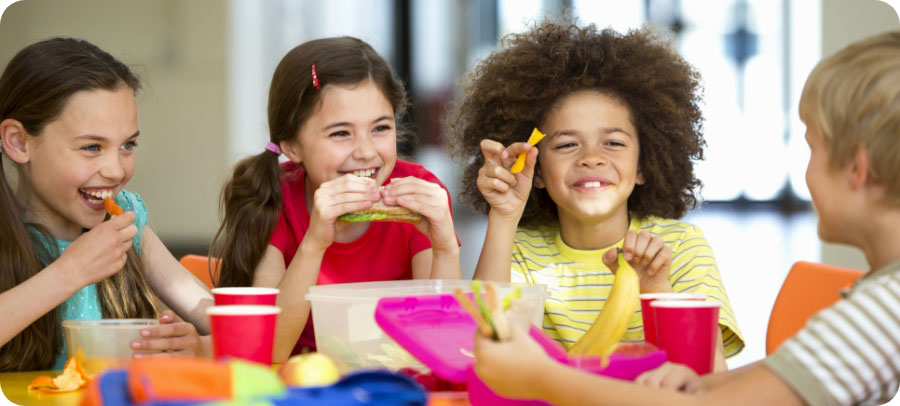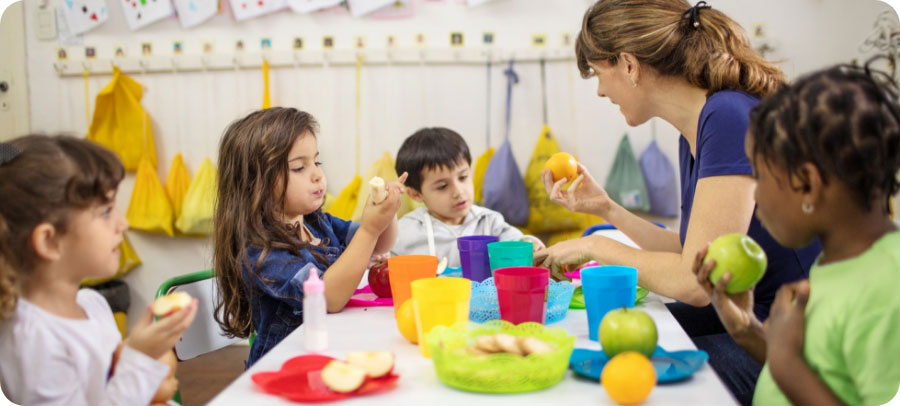What is the Division of Responsibility in Feeding and how does it apply in schools?
The Division of Responsibility in Feeding outlines the different roles that adults and children have with regards to feeding and eating.
In the school context, the school’s role is to:
- provide consistent mealtimes
- ensure student have enough time and a pleasant space to eat
- provide access to nourishing food choices
- respect food choices brought from home
Students decides:
- Whether or not to eat
- The order of the food items they choose to eat
- How much to eat
- What to eat from food provided
| Caregiver decides | School decides | Student decides |
|---|---|---|
|
|
|
But then how do I “get kids to eat healthy foods?”
Many adults feel that they need to try all sorts of strategies to get children to eat certain foods, including encouraging, reminding, cheering, rewarding, bribing, or telling a child how healthy the food is for them. This might sound like “Try it, you will like it!” or “Eat your sandwich before going outside to play”. These are all forms of pressure. While these strategies may get a child to take a bite at that moment, in the long run pressure can make it harder for them to enjoy a variety of foods on their own. It can also teach them to ignore their body’s cues. For children who have experienced trauma around food, pressure can make mealtimes feel unsafe.
As outlined in the Satter Division of Responsibility in Feeding, the adult or school decides what foods are being offered for meals and snacks. The types of foods adults choose to offer may consider children’s preferences, allergies and sensitivities as well as their nutritional needs. Research shows that when we focus on our role of regularly offering a variety of foods, children will get what they need.
Examples of language that supports the Division of Responsibility in Feeding:
| Language to Try | Language to Avoid |
|---|---|
|
“Would you like to try some?” (If they say no, respect this decision) “How does it taste–sweet or sour?” “I added apples and cinnamon to this oatmeal. See what you think.” “Would you like more?” “Is your tummy telling you that you are full?” “If you try it and don’t want to swallow it, you can ask me for a tissue and politely spit it out.” “I put mushrooms on the pizza. If you don’t want to eat them, you can pick them out.” |
“Take at least one bite for me.” “How do you know you don’t like it if you haven’t even tried it?” “Are you this picky at home?” “If you finish your toast, you can have a granola bar.” “If you eat this, you can go outside and play.” “Good boy! You finished all your food!” |
|
Language that is helpful will:
|
Language to avoid will:
|
What about food waste? Sometimes, when we honour a student’s right to decide how much or whether to eat, there is food waste. Food waste can be upsetting, but it is also a necessary part of learning how to eat. Giving students pressure-free opportunities to try food, taste and put food back down, or not finish what is on their plate, creates the comfort and safety needed to develop eating competence. To minimize food waste:
- Have students start with a small amount and let them know they can come back for seconds if they want more.
- Allow students enough time to eat.
If possible, compost uneaten food so that it is not “wasted”, but rather recycled back into soil.
Common questions and answers on the Division of Responsibility in Feeding for school settings
“Hudson only wants to eat bread with butter at our breakfast program. He won’t eat any of the healthy stuff– the fruit or the eggs. What should I do?”
As school food providers, we cannot know all the circumstances and contexts of a student’s life, including the reasons why they don’t want to eat certain foods. What we can do is offer a variety of nourishing foods alongside some familiar foods and allow Hudson to decide what and how much to eat. This allows Hudson to trust his body and build eating competence at his own pace. It also builds trust between Hudson and the caring adult providing food. Children do not eat food “because it is healthy.” In fact, pressuring children to eat something that they don’t want often results in a food aversion; or worse, it can become a reason they don’t want to participate in a school food program. Offering familiar foods along with nourishing foods, while teaching children to say “no thank you” and accepting their preferences gives children the opportunity to build trust and explore new foods at their own pace.
What you can do: Allow Hudson to eat as much bread as he needs to feel full. When he says “no thank you” to fruit and eggs, honour that decision. Be friendly, make him feel comfortable and safe, have him sit down with his peers and enjoy his bread. One day, when he is ready, he will try the fruit and eggs.
Students need to build comfort with food at their own pace. This can be done by seeing it, touching it, growing it, or watching others eat it, without any pressure to try it themselves. One strategy is to not talk about food at all. Instead, focus on relaxing and connecting with the student and engaging in mealtime conversations. If talking about food with students, focus on its sensory qualities like colours, flavours and textures, rather than describing food as healthy or unhealthy.
Additional resources on how to talk about food with students:
- Teaching and talking to students about food and nutrition from Teach Food First
- Suggested Answers to Common Food & Nutrition Questions from Students from Teach Food First
- Talking Tips for School Food Providers from the Interior Health Authority
“I am a teacher of grade 4 students. At the beginning of the year, I write a note home to parents asking them not to send junk food to school.”
Food choices sent from home are the choice of the caregiver and may be influenced by many things including culture, a child’s food preferences and socioeconomic status. Teachers, administrators, and school staff are only responsible for the foods offered by the school and should not create or enforce rules regarding food sent from home. If there are concerns about the adequacy of a student’s lunch, consider speaking with a school counsellor and/or directly with the child’s parent or caregivers to explore possible support for that student and family.
Schools are not responsible for deciding what foods should be sent from home as part of a child’s lunch. If there are concerns about adequacy, these can be discussed with the caregiver.
“I always tell students to eat their vegetables and fruits first, as these foods are healthy and will make them ready to learn.”
As outlined in the Satter Division of Responsibility in Feeding, the order of eating is a responsibility of the student and builds eating competence. Telling a student how to eat can feel like pressure and can be a deterrent to enjoying their food. Instead, schools can support students in eating vegetables and fruits by offering food literacy opportunities in the classroom or garden, or offering vegetables and fruits choices in school food programs.
Students decide whether to eat, how much to eat, and the order in which they eat.
“The sugary foods sent in my students’ lunches are dysregulating their behaviour! When they don’t eat a healthy lunch, they can’t sit still and learn. What should I do?”
While we know nutritious, balanced meals are supportive for learning, we also recognize that many factors influence the foods a caregiver packs in a child’s lunch. This includes finances, food access, food literacy, culture and more. Decisions about food packed from home are the role of the caregiver (not the school or teacher). In the classroom, teachers can support healthy school food environments by:
- Choosing to offer nutritious foods as part of classroom activities and celebrations, and choosing non-food rewards in the classroom.
- Offering nutritious foods as part of a school meal or snack program.
- Ensuring sufficient time for students to sit down and enjoy their lunch or snacks with their friends.
- Talking about food in a neutral manner (i.e., not labelling food as “good”, “bad” or “different”).
- Limiting distractions by creating a calm and respectful eating environment.
- On occasion, eating together with students, taking the time to connect, and role-model enjoyment of eating and social norms (table manners).
- Providing opportunities to taste nutritious foods through food literacy activities in the classroom, including gardening and cooking (see Teach Foods First, or Hands on Food).
Additional Resources on the Division of Responsibility in Feeding
- “Nurturing Healthy Eaters in Elementary Schools” and “Nurturing Healthy Eaters in Secondary Schools” from Ontario Dietitians in Public Health.
Compassion-informed Care: Avoid negative comments (or disapproving faces/body language) about a student’s lunch. Recognize that all students come from different home eating environments, and that is okay. If a child has inadequate amounts of food regularly, this should be brought up with the school counsellor or the child’s care giver to find out if they need support.
“For many Indigenous communities, food is a love language… ensure that
food access comes without restriction or consequence.”
– Respondent from First Nations Engagement Survey on School Food Environments

